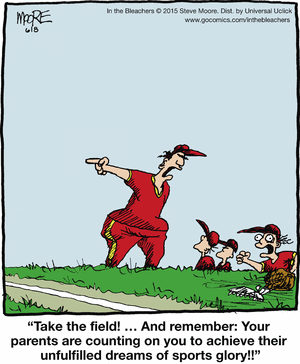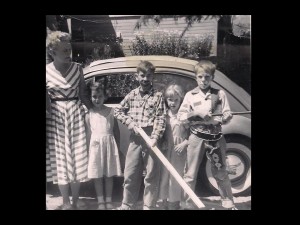Hanging With The Grandkids And Not Striking Out
My friend, David Williams, recently got home from hanging with his grandkids and trying not to strike out. I thought he’d have a blast, but being blasted would have been much more to the point.
He responded to what a visit to see his young grandkids was like:
One night, my granddaughter (11) had a piano recital, while my older grandson (9) had a baseball game, and the third (4) just had four year old things to do. Pop Pop tries not to pry too much into les affaires des enfants.
Since there are two of us, we divied up the grandparent duties as befits a modern family. Me, Pop Pop, was taken out to the ballgame.
Back in the day we didn’t start playing organized baseball until about age 12 or so, because the two most common things done in baseball are throw and catch. Nine year-olds do the former poorly and the latter not at all. What they lack in skill they make up for with intent, which I observed to be the wrong approach.

This is what it is like:
First, remember that they play by actual baseball rules, which means the ball is always live once the ump puts it in play, and remains so until a player calls for a timeout or hits a foul ball.
At all other times anyone on base may attempt to run to the next base. When not much is happening, even professional players tend to forget this. Nine year-olds forget everything.
At the beginning of an inning, the pitcher throws ball after ball. By ball, I mean not a strike. About half of these hit the backstop, but this at first has little effect on the game, because, of course, a batter can’t advance unless he has hit it. After the the fourth ball, however, this changes dramatically.
Coaches know everything I have just said. So, when the first batter walks – a near certainty – he will soon run to second. This will happen if the next pitch goes to the backstop, it will happen if the ball doesn’t go to the backstop, it will happen if the pitcher simply stands on the mound and looks toward home, or even if the pitcher decides to go home and ask his mom for a cookie.
He’s going to second. This is because no one can actually throw it as far as second base, and if one of them does throw it that far, the ball will likely roll to the center field fence. The runner goes to second, you then see the catcher rise up to throw, you then anticipate the play at second … then you hear everyone in the dugout hollering, “Don’t throw! Don’t throw!”
It now occurs to you that you will be there a while.

This leaves first base open, which in three more pitches is filled by the next walked batter. The fun now starts. The next pitch is often the first strike of the inning, which the batter lunges at, nearly falling down, but the bat connects with the ball, which begins a slow roll between the mound and third base.
It’s a mad scene, with both runners and the batter going like crazy. The third baseman picks up the now inert ball, and throws it to first. The batter is by this time standing on first with his hands on his hips, and watches the ball sail over everyone’s head toward his own dugout, where everyone rightfully ignores it.
Now all the runners are going again. Coaches are waving their hands, and defensive players are running around as much as the base runners. People in the stands are standing and screaming. The poor first baseman – none of this is his fault – has retrieved the ball and, reasonably assuming the ball is now dead, starts walking with it towards the field. Well, it ain’t dead. It ain’t even cold.
The coach screams “Throw it!”, even though we all heard him scream at the catcher not to, and even us granddads can’t figure out who to throw it to, what with all the motion. By now the first walked batter has scored, the second one is headed to third, and the most recent batter is headed to second. He inexplicably throws it home, where it goes to the backstop. The second runner continues around third and scores.
The catcher has by now picked up the ball at the backstop, and following his training he throws it to the pitcher who is covering home, even though the second runner is already sitting in the dugout.
The ball is now rolling toward second base, so the batter on second takes off for third. The second baseman picks it up and throws it to third, and the ball rolls into his dugout. The batter continues to home and scores.
At this point there are no runners left, so the umpire can mercifully wave his hands above his head and say, “Ball is dead”, and 22 players, 6 coaches and 46 fans can finally sit and relax. Nothing can happen until the next batter is in the box, the ump points at the pitcher, which puts the ball in play, and it all starts over.
This could go on until 3 the next afternoon. But Hallelujah, there is a countdown clock on the scoreboard. On the first pitch it starts counting down from 75 minutes to zero. At zero they had played one inning, there was one out in the second inning, and there was a guy on first (denied second base only by the clock). The score was 7 to 5. In a 9 inning game that’s a score of 63 to 45, so I’m all for time clocks.
But the Mighty Broncos (my grandson’s team) had won.

He was the starting pitcher, and all the above aside, he did very well. He walked 2 of every 3 batters he faced, but that was better than anyone, and all the outs were strikeouts. In typical fashion, he was completely unfazed. We went to his favorite burger place afterward, and Pop Pop sincerely complimented him on his game.
Pop Pop asked, “So, what was it like, two runs are in, runners are on base, you’re looking in at the catcher, and you strike the guy out. What was that like?”
He just shrugged his shoulders. “It got kind of boring. Throw another pitch, throw another pitch, throw another pitch. I was bored.”
Look kid, you don’t walk out onto a $5 million Little League field, wearing a $50 uniform, a $60 glove and $70 shoes, have your dad miss his daughter’s recital, have your Pop Pop drive 1300 miles, and say it was boring. Let’s try this again …
But Pop Pop didn’t say that. Instead, he complimented him on his cool demeanor. Which it was. And he can really throw. For a nine year-old.
Then we got home, and Pop Pop is ready to get back to the hotel. But the other two kids are absolutely sure that Pop Pop’s day has been ruined by not having spent the evening with them, so they demand equal time to fix that.
That was one evening of one day. Pop Pop is too old for this. That’s what it’s like.




